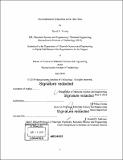| dc.contributor.advisor | Yet-Ming Chiang. | en_US |
| dc.contributor.author | Young, David Y. | en_US |
| dc.contributor.other | Massachusetts Institute of Technology. Department of Materials Science and Engineering. | en_US |
| dc.date.accessioned | 2019-11-12T17:40:00Z | |
| dc.date.available | 2019-11-12T17:40:00Z | |
| dc.date.copyright | 2018 | en_US |
| dc.date.issued | 2018 | en_US |
| dc.identifier.uri | https://hdl.handle.net/1721.1/122864 | |
| dc.description | Thesis: S.M., Massachusetts Institute of Technology, Department of Materials Science and Engineering, 2018 | en_US |
| dc.description | Cataloged from PDF version of thesis. | en_US |
| dc.description | Includes bibliographical references (pages 51-55). | en_US |
| dc.description.abstract | Metal hydrides are pertinent to several applications, including hydrogen storage, gas separation, and electrocatalysis. The Pd-H system is used as a model for metal-hydrogen systems and the effect H insertion has on their properties. A study was conducted to assess the performance of various electrochemical cell formats in electrochemically inserting H into Pd, which is important in building devices for the above applications. A set of in situ X-ray diffraction apparatuses were built to enable simultaneous electrochemical H insertion and measurement of PdH[subscript x] composition. A comparison between aqueous and solid electrolytes, temperature, and thin film vs. bulk Pd revealed that thinner films, lower temperatures, and aqueous electrolytes tended to promote higher achievable H content, with the highest H:Pd ratio observed being 0.96 ± 0.02. These results not only show high H loading into Pd but also both reproducibility and a clear association between varied parameters and cell performance. In addition, the stability and performance of high temperature solid oxide electrolytes was investigated. A novel in situ calorimeter was constructed to enable the study of high temperature solid oxide electrolyte degradation while under operating conditions, similar to recent work in calorimetric analysis of battery stability. This calorimeter has a power detection sensitivity of 16.1 ± 11.7 mW, which is sufficient for detecting and quantifying many of the degradation and other side reactions that occur during high temperature operation of a solid oxide electrolyte in an electrochemical cell. This apparatus provides a tool needed to assess stability and life of solid oxide electrolytes under operation, a critical component to developing higher performing solid oxide electrochemical devices. | en_US |
| dc.description.statementofresponsibility | by David Y. Young. | en_US |
| dc.format.extent | 55 pages | en_US |
| dc.language.iso | eng | en_US |
| dc.publisher | Massachusetts Institute of Technology | en_US |
| dc.rights | MIT theses are protected by copyright. They may be viewed, downloaded, or printed from this source but further reproduction or distribution in any format is prohibited without written permission. | en_US |
| dc.rights.uri | http://dspace.mit.edu/handle/1721.1/7582 | en_US |
| dc.subject | Materials Science and Engineering. | en_US |
| dc.title | Electrochemical H insertion in Pd thin films | en_US |
| dc.type | Thesis | en_US |
| dc.description.degree | S.M. | en_US |
| dc.contributor.department | Massachusetts Institute of Technology. Department of Materials Science and Engineering | en_US |
| dc.identifier.oclc | 1126541151 | en_US |
| dc.description.collection | S.M. Massachusetts Institute of Technology, Department of Materials Science and Engineering | en_US |
| dspace.imported | 2019-11-12T17:40:00Z | en_US |
| mit.thesis.degree | Master | en_US |
| mit.thesis.department | MatSci | en_US |
